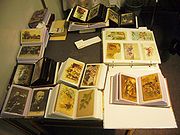
Deltiology
Encyclopedia

Postcard
A postcard or post card is a rectangular piece of thick paper or thin cardboard intended for writing and mailing without an envelope....
s. Professor Randall Rhoades of Ashland, Ohio, coined a word in 1945 that became the accepted description of the study of picture postcards. It took about 20 years for the name to appear in the dictionary the first time. Compared to philately
Philately
Philately is the study of stamps and postal history and other related items. Philately involves more than just stamp collecting, which does not necessarily involve the study of stamps. It is possible to be a philatelist without owning any stamps...
, the identification of a postcard's place and time of production can often be an impossible task because postcards, unlike stamps, are produced in a decentralised, unregulated manner. For this reason, some collectors choose to limit their acquisitions to cards by specific artists and publishers, or by time and location.
Identification
There are some general rules to dating when a postcard was printed. Postcards are generally sent within a few years of their printing so the postmark helps date a postcard. If the card is original and not a reprint, a postcard's original printing date can be deduced from such things as the fashions worn by people in the card, the era in which the cars on the street were made, and other time-sensitive clues. Postcards produced by the Curt Teich Company can be dated more exactly if the stamp box on the reverse is visible, since the company printed a date code within the stamp box. A guide to the year published is available at Guide to dating Teich cardsPicture postcards (PPCs) can be assigned to "the Golden Age of Postcards" (1898–1919), the time of the linens (circa 1930-1950), or to the modern chromes (after 1940). Modern chromes are color photographs and thus differ from photochromes generated from black and white photographs before ca. 1915. PPCs can also be differentiated on the basis of other features: undivided backs are typical for c1901-1906, and divided backs for c1907-1915, while white border cards are common from c1915-1930.
Practice
Postcards are collected by historical societies, libraries and genealogical societies because of their importance in research such as how a city looked at a particular time in history as well as social history. Many elementary schools use postcards to teach children geography. Postcard Penpal programs have been established to help children in language arts.Deltiologists, as postcard collectors are called, collect for a variety of reasons. Some are attracted to the postcards themselves, then narrow down their interests. Others are interested in something in particular, such as Ballet, then decide to collect Ballet related postcards as a way to augment their interest in Ballet.
One of the most popular areas of collecting is "town views" – actual scenes from a particular town or region. Most collectors of town views start by collecting views of the town where they reside or the town where they grew up. With many small towns having hundreds of different cards available, it is an area that can keep a collector busy for years.
The hottest cards in the town view category are real photo postcards (RPPCs), postcards printed on actual photographic paper using the photographic process rather than printed cards created on a printing press. The attraction of a RPPC is that the scene shown is an actual scene from the past whereas a printed card can often be an artist's conception of how the particular scene appeared. RPPCs are usually much rarer than printed cards as printed cards were easier to produce in large numbers. The most reliable method of differentiating the two is with a magnifying glass. A printed card viewed through a glass will display a series of dots used to create the image that are lacking in a RPPC. Another way to identify a RPPC is by information on the back of the card. Older RPPS may also display a silver sheen in the darker areas when viewed at an angle due to the silver used in the early photographic process.
Collectors may find PPCs at home in boxes, attics, or scrapbooks, generate their own on trips and vacations, and acquire them from stores, fleamarkets, purchasing on the Internet, or other collectors.
A number of artists have become recognized for the creation of postcards and certain publishers specialize in the production and printing of PPCs.
Worldwide popularity
Worldwide, deltiology is thought to be the third largest hobby after stamp collecting and coin/banknote collecting. Postcard clubs may be found in many countries; and these clubs, as well as related organizations, frequently host postcard shows.External links
- Worldwide postcard exchange project
- http://viewfinder.english-heritage.org.uk UK online archive from the National Monuments Record, the public archive of English HeritageEnglish HeritageEnglish Heritage . is an executive non-departmental public body of the British Government sponsored by the Department for Culture, Media and Sport...
, of nearly 5000 postcards collected by Nigel Temple. Use Advanced Search/Collections/Nigel Temple Postcards to view. The main theme of this collection is public parks and gardens. Coverage of the collection is national, and the bulk of the postcards date between 1900 and 1910. - postaletrice A growing collection of select vintage photographic postcards from all over the world, classified by location and topic.
- Award-winning Art from Vintage Postcards -- Collection of vintage digitally colorized postcards
- Vintage Postcard Forum -- Collecting vintage postcards

